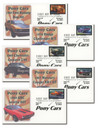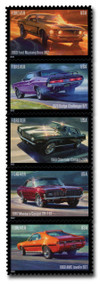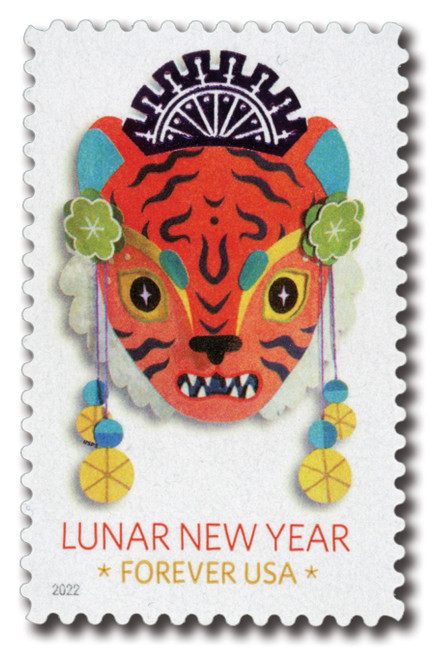
# 5715-19 - 2022 First-Class Forever Stamps - Pony Cars
US #5715-19
2022 Pony Cars
- Celebrates America’s love of pony cars with five stamps, each picturing a different model
- Designs really make you feel nostalgic for the days these cars ruled the roads
Stamp Category: Commemorative
Value: 60¢ First Class Mail Rate (Forever)
First Day of Issue: August 25, 2022
First Day City: Sacramento, California
Quantity Issued: 45,000,000
Printed by: Ashton Potter (USA) Ltd.
Printing Method: Offset
Format: Panes of 20
Tagging: Nonphosphored type III, block tag
Why the stamps were issued: To honor a small handful of the many pony cars that have inspired American imaginations and made them want to own one of these iconic cars for themselves.
About the stamp designs: Each pictures a dramatic oil painting capturing the very essence of what makes pony cars special. Original artwork by Tom Fritz.
First Day City: The First Day of Issue Ceremony was held at the Great American Stamp Show in Sacramento, California.
History the stamp represents: In the 1960s, pony cars ruled America’s roads and racetracks. As younger drivers were looking for fast, affordable, sporty cars, auto manufacturers competed for their business and attention, sparking the fierce pony car wars.
The Plymouth Barracuda was the first pony car available for sale (two weeks before the Ford Mustang), but it didn’t sell well. Released on April 17, 1964, the Ford Mustang was an instant hit. Ford expected to sell 100,000 in their first year. They sold over one million Mustangs within two years. The Mustang shattered sales records and it wasn’t long before their competitors joined in the race.
The Mustang was followed by the Chevy Camaro, Mercury Cougar, and AMC Javelin in 1967 and Dodge unveiled its Challenger in 1969. The term pony car was coined by Car Life magazine, which described the cars as sporty, compact, and for the masses, with a long hood, short deck, and affordable price. Pony cars were also highly customizable. With a wide range of available features, paint colors, and trim stylings, these cars could be as unique as their drivers.
Manufacturers pitted their cars against one another in a variety of races, most notably the Trans-Am Series. Pushing the idea of “Win on Sunday, Sell on Monday,” these races helped increase sales across the country. Before long, enthusiastic drivers were staging their own street races, testing out the pony cars’ abilities for themselves.
US #5715-19
2022 Pony Cars
- Celebrates America’s love of pony cars with five stamps, each picturing a different model
- Designs really make you feel nostalgic for the days these cars ruled the roads
Stamp Category: Commemorative
Value: 60¢ First Class Mail Rate (Forever)
First Day of Issue: August 25, 2022
First Day City: Sacramento, California
Quantity Issued: 45,000,000
Printed by: Ashton Potter (USA) Ltd.
Printing Method: Offset
Format: Panes of 20
Tagging: Nonphosphored type III, block tag
Why the stamps were issued: To honor a small handful of the many pony cars that have inspired American imaginations and made them want to own one of these iconic cars for themselves.
About the stamp designs: Each pictures a dramatic oil painting capturing the very essence of what makes pony cars special. Original artwork by Tom Fritz.
First Day City: The First Day of Issue Ceremony was held at the Great American Stamp Show in Sacramento, California.
History the stamp represents: In the 1960s, pony cars ruled America’s roads and racetracks. As younger drivers were looking for fast, affordable, sporty cars, auto manufacturers competed for their business and attention, sparking the fierce pony car wars.
The Plymouth Barracuda was the first pony car available for sale (two weeks before the Ford Mustang), but it didn’t sell well. Released on April 17, 1964, the Ford Mustang was an instant hit. Ford expected to sell 100,000 in their first year. They sold over one million Mustangs within two years. The Mustang shattered sales records and it wasn’t long before their competitors joined in the race.
The Mustang was followed by the Chevy Camaro, Mercury Cougar, and AMC Javelin in 1967 and Dodge unveiled its Challenger in 1969. The term pony car was coined by Car Life magazine, which described the cars as sporty, compact, and for the masses, with a long hood, short deck, and affordable price. Pony cars were also highly customizable. With a wide range of available features, paint colors, and trim stylings, these cars could be as unique as their drivers.
Manufacturers pitted their cars against one another in a variety of races, most notably the Trans-Am Series. Pushing the idea of “Win on Sunday, Sell on Monday,” these races helped increase sales across the country. Before long, enthusiastic drivers were staging their own street races, testing out the pony cars’ abilities for themselves.


















